Irresistibly Creamy Basque Burnt Cheesecake: A Heavenly Treat
Basque burnt cheesecake is a bold twist on traditional desserts.
This Spanish treat has won over dessert lovers everywhere with its unique look and rich taste.
Unlike the smooth, classic cheesecakes, this one boasts a dark, caramelized top that adds character.
It’s baked at high temperatures to achieve that almost-burnt appearance, but don’t let the name fool you; it tastes incredibly deep and flavorful.
Hailing from San Sebastian, it breaks the rules of typical baking with its cracked surface and rustic charm.
Both seasoned bakers and those new to baking have come to appreciate this innovative creation for its spontaneous beauty and simple elegance.
Why Basque Burnt Cheesecake Tastes So Rich
What Goes Into Basque Burnt Cheesecake
Main Ingredients:
Dairy Base:Sweeteners and Binding:Supporting Ingredients:Steps For Making Basque Burnt Cheesecake
Step 1: Warm Up The Oven
Fire up your oven to 210°C (410°F) to create the perfect baking environment.
Step 2: Dress The Baking Vessel
Wrap an 8-inch round pan with parchment paper, letting edges dramatically drape over sides for effortless cake extraction.
Step 3: Whip The Silky Base
Gather your creamy companions:Beat cream cheese and sugar until luxuriously smooth. Sprinkle in flour, mixing thoroughly. Gently introduce eggs one at a time, whisking after each arrival. Drizzle vanilla and cream, blending until just harmonized.
Step 4: Eliminate Sneaky Bubbles
Pour batter into prepared pan. Tap pan against counter to banish hidden air pockets. Use a toothpick to puncture any stubborn bubbles.
Step 5: Bake To Bronzed Perfection
Slide pan onto center oven rack. Bake for 45 minutes until top transforms into a deep bronze landscape with elegant cracks. Center should wobble like gentle waves.
Step 6: Patient Cooling Ritual
Allow cheesecake to rest at room temperature for 2 hours. Transfer to refrigerator and chill for minimum 4 hours, letting flavors meld and texture settle.
Step 7: Slice And Celebrate
Cut into dreamy wedges and savor your caramelized masterpiece.
Smart Ideas For Basque Burnt Cheesecake
How To Store And Reheat Basque Burnt Cheesecake
Tasty Matches With Basque Burnt Cheesecake
Basque Burnt Cheesecake Twists To Try
FAQs About Basque Burnt Cheesecake
The high-temperature baking creates a caramelized, dark exterior while maintaining a creamy, almost custard-like center that’s intentionally soft and jiggly.
Yes, this style originated in San Sebastian, Spain, at a restaurant called La Viña, and has since become a globally recognized dessert with its distinctive burnt top and creamy interior.
The high heat (210°C/410°F) causes the edges to caramelize and create a dramatically dark, cracked top while keeping the center soft and custardy, which is the signature characteristic of Basque Burnt Cheesecake.
Use full-fat, room temperature cream cheese for the best texture and richness. Philadelphia or similar block-style cream cheese works best, avoiding whipped or low-fat varieties that might affect the final consistency.
Print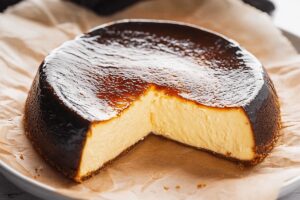
Irresistibly Creamy Basque Burnt Cheesecake Recipe
- Total Time: 1 hour 10 minutes
- Yield: 8 1x
Description
Basque Burnt Cheesecake delivers a creamy, cracked masterpiece that defies traditional dessert expectations. Rich, caramelized edges and a silky center make you crave each indulgent slice of this Spanish culinary marvel.
Ingredients
Main Ingredients:
- 750 grams (26.5 ounces) cream cheese, room temperature
- 5 large eggs, room temperature
- 1 cup heavy cream, room temperature
Sweeteners:
- 1 cup sugar
Stabilizers:
- ⅛ cup flour
- 1 teaspoon vanilla extract
Instructions
- Prepare the baking environment by positioning the oven rack in the center and heating to 210°C (410°F), creating an ideal environment for the unique Basque-style dessert.
- Create a protective parchment paper lining for an 8-inch round pan, allowing generous overhang to facilitate effortless cake extraction after baking.
- Utilize an electric mixer to transform cream cheese and sugar into a velvety, homogeneous mixture, ensuring no lumps remain.
- Gently incorporate flour into the creamy base, maintaining a smooth texture without overmixing.
- Introduce eggs individually, blending each thoroughly to maintain the batter’s silky consistency, followed by a splash of vanilla extract for aromatic depth.
- Delicately stream heavy cream into the mixture, stirring until just combined to preserve the batter’s delicate structure.
- Transfer the mixture into the prepared pan, employing gentle taps against the counter to dislodge any trapped air bubbles, using a toothpick to puncture stubborn pockets.
- Position the pan in the preheated oven, allowing the cheesecake to bake for approximately 45 minutes until the surface develops a rich mahogany color with distinctive cracking.
- Verify doneness by observing a deeply caramelized exterior while maintaining a wobbling, custard-like center.
- Allow the cheesecake to rest at room temperature for two hours, enabling natural cooling and structural settling.
- Refrigerate for a minimum of four hours to complete the setting process and enhance flavor development.
- Carefully slice and serve, revealing the cake’s characteristic burnt edges and creamy interior.
Notes
- Master temperature control by using a reliable oven thermometer to ensure precise 210°C heat for achieving the signature burnt exterior.
- Prevent sticking by generously overlapping parchment paper, creating tall pleated sides that allow dramatic rising and caramelization during baking.
- Select full-fat cream cheese at room temperature to guarantee smooth blending and prevent lumpy batter texture, which impacts final cheesecake consistency.
- Embrace imperf
- Prep Time: 10 minutes
- Cook Time: 1 hour
- Category: Desserts
- Method: Baking
- Cuisine: Basque
Nutrition
- Serving Size: 8
- Calories: 350
- Sugar: 30 g
- Sodium: 200 mg
- Fat: 28 g
- Saturated Fat: 17 g
- Unsaturated Fat: 10 g
- Trans Fat: 0 g
- Carbohydrates: 25 g
- Fiber: 0 g
- Protein: 6 g
- Cholesterol: 120 mg

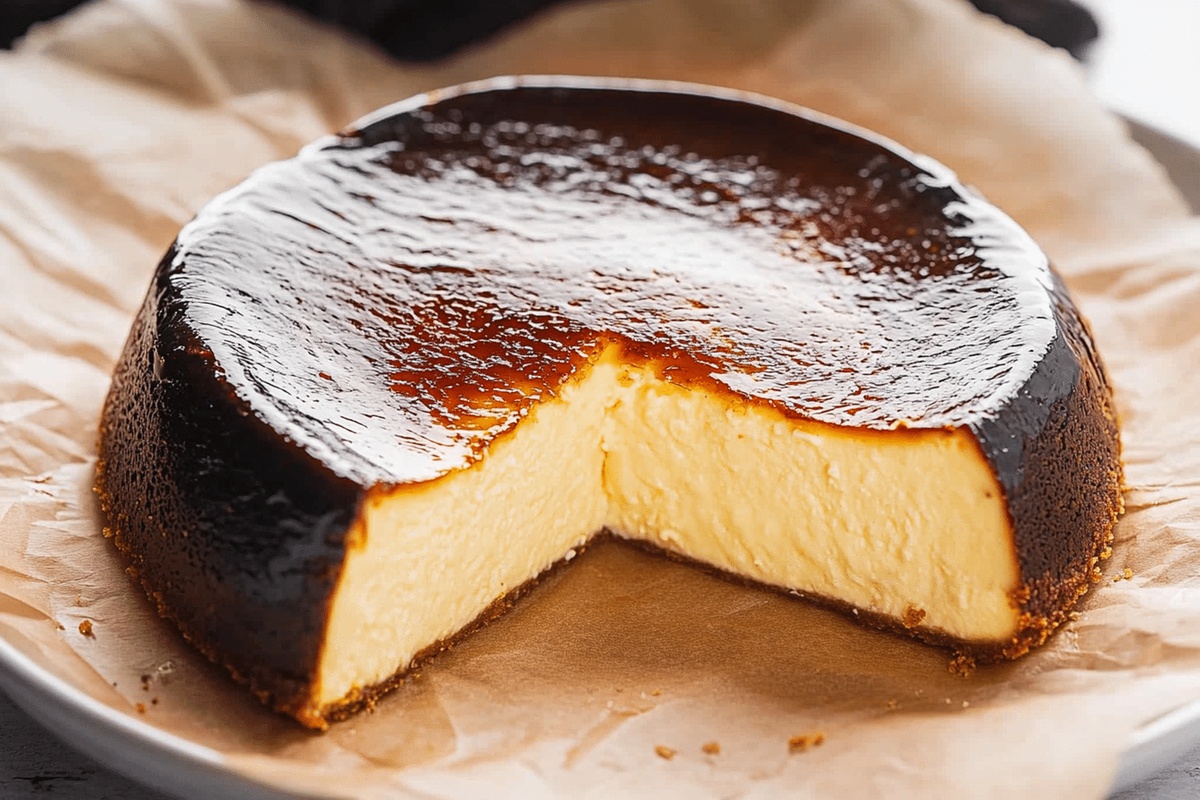
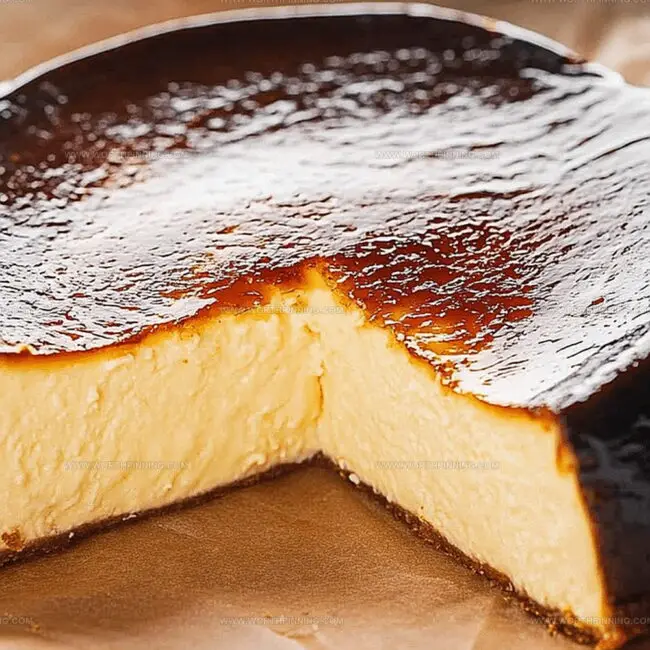
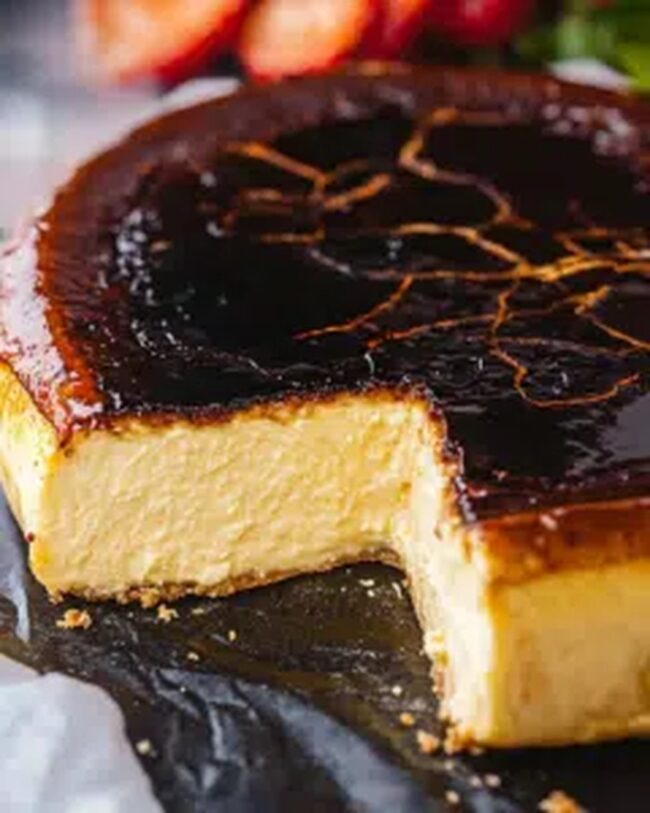
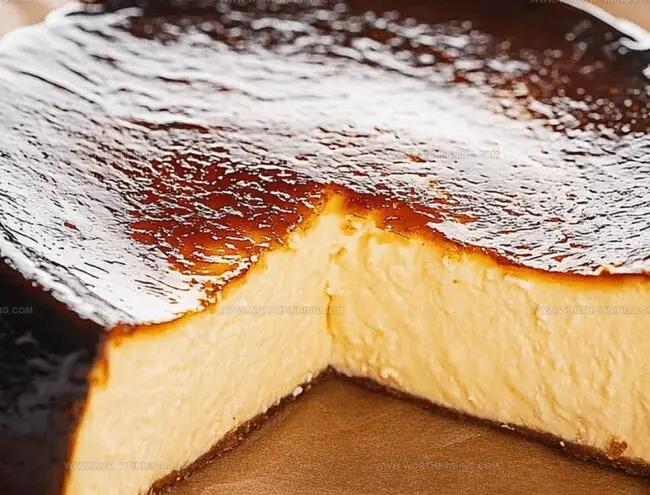
Sophia Rivera
Recipe Developer & Kitchen Tips Specialist
Expertise
Education
Austin Community College
San Antonio Culinary Institute
Sophia’s passion for baking began in her family kitchen, where she spent hours experimenting with new recipes. With a background in baking and pastry arts, she loves making desserts that are as visually stunning as they are delicious.
Sophia is all about using seasonal, locally sourced ingredients to create treats that everyone will enjoy. When she’s not creating mouth-watering desserts, you can find her gardening, making new recipes, or enjoying a relaxing afternoon with her family.